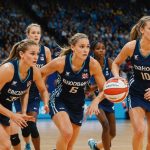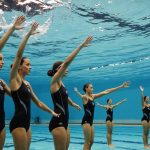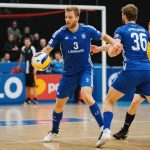Overview of Hand-Eye Coordination in Basketball
Hand-eye coordination stands as a pivotal skill within basketball, influencing the basketball shooting technique and overall performance. It represents the harmonious alignment between vision and body movements to handle the ball effectively. This coordination is crucial for achieving precision and accuracy in ball shooting, ensuring players score consistently.
In basketball, precise hand-eye synergy optimises shooting accuracy. Players must perceive the basket’s location swiftly and coordinate their physical movements to execute a shot accurately. Insufficient coordination can lead to missed opportunities and reduced effectiveness on the court.
This might interest you : Maximizing court awareness: unique techniques for uk basketball players to sharpen peripheral vision
Now, focusing on the UK basketball scenario, hand-eye coordination is emphasised heavily during training sessions. Given the competitive nature of UK basketball leagues, players are trained to refine their skills continually. Superior coordination not only enhances a player’s shooting technique but also aids in faster reflexes during high-pressure situations.
Overall, mastering hand-eye coordination leads to an improved basketball shooting technique, as shooters become more adept at positioning, aiming, and timing their shots. This skill significantly impacts a player’s contribution to team success, making it a primary focus in basketball training and development.
This might interest you : Boosting performance: essential tactics for uk basketball players to conquer mid-season challenges
Proven Drills for Enhancing Coordination
In basketball, coordination drills are instrumental for honing the skills crucial for success. Such drills focus on synchronising vision and movement, thereby boosting a player’s effectiveness on the court. Coordinated effort in training refines shooting technique, enhancing precision and adaptability.
Catch and Shoot Drill
This drill sharpens quick decision-making and shooting technique. Players practise catching the ball and launching a shot in one seamless motion. Coaches frequently recommend beginning at shorter distances, gradually increasing with proficiency. Generally, practising this 2-3 times weekly ensures notable improvements.
Dribble and Shoot Drill
This enhances ball control while maintaining shooting precision. Players dribble across the court, pause, and shoot. The exercise boosts agility and helps players adjust to on-the-go shots. To advance further, players can increase both speed and complexity of dribbles, typically engaging in it about twice a week.
Wall Pass Drill
Wall passes improve hand-eye coordination by having players pass the ball against a wall and intercept it effectively. It reinforces fundamental skills—accuracy, timing, and reflexive passing. An incremental approach, using varied angles and distances, is optimal for skill diversification. Regular weekly integration in training, tailored to skill levels, is highly advantageous for players.
Expert Tips from Coaches and Players
In the vibrant world of UK basketball, insights from seasoned coaches and players can dramatically enhance hand-eye coordination. Basketball coaching often focuses on maintaining a disciplined training routine. Coaches recommend blending coordination drills with other skills for a well-rounded approach. For instance, incorporating reaction time exercises can boost a player’s on-court agility.
Anecdotes from successful players reveal the importance of consistency. One player shared how practising specific drills daily improved his basketball shooting technique significantly over time. Training isn’t just about quantity but also quality. Regular, focused sessions tend to yield better results than sporadic, high-intensity practices.
Common pitfalls abound during training, which can hinder progress. One frequent mistake is neglecting rest and recovery. Exhaustion can lead to decreased precision in skills, so balancing urgency and patience is vital. Additionally, over-relying on routine without periodically introducing new challenges could cap growth. Adjusting practice to maintain engagement and facilitate improvement is essential.
Furthermore, the mental component of coordination should not be ignored. Coaches advise players to visualise successful performances, as this fosters confidence and sharpens focus. This mental rehearsal complements physical drills, resulting in a comprehensive improvement in hand-eye coordination.
The Role of Technology in Training
Incorporating training technology into basketball sessions can significantly amplify a player’s development. Modern basketball shooting aids are transforming the practice landscape, offering detailed insights and enhancements to skills. Diverse tools are now available to help refine techniques, making training more efficient and enjoyable.
Utilizing Apps for Skill Tracking
Many apps are designed to monitor a player’s skill progress. These applications enable easy recording and analysis of shooting metrics, which aids in identifying areas needing improvement. By consistently using these apps, players can track their development over time, understanding their strengths and weaknesses more clearly.
Video Analysis for Technique Improvement
Video analysis has become an invaluable asset in honing shooting techniques. By reviewing footage, players gain insights into their form and execution, allowing them to make necessary adjustments. It provides a clear, objective view of performance, fostering a deeper understanding of technique refinement.
Virtual Reality Training Programs
Virtual reality introduces an immersive element into training programs. It allows players to practice in simulated environments, enhancing mental preparation and responsiveness to game-like situations. This technology is not just about repetition; it’s about creating realistic scenarios where players can apply and test skills under varying degrees of pressure.
Psychological Aspects of Coordination Training
In basketball, mental training plays a pivotal role alongside physical preparation. Performance psychology is essential for developing robust hand-eye coordination. Concentration and confidence form the core psychological elements aiding coordination, directly impacting a player’s ability to perform under pressure.
Mental exercises complement physical drills by strengthening cognitive aspects of coordination. Techniques like visualisation help players mentally rehearse successful shots, enhancing focus. Imagining the trajectory of the ball and positive outcomes can increase precision in actual performance.
Balancing mental focus with confidence is crucial. While focus ensures accuracy, confidence fosters resilience in varying court conditions. Techniques to build confidence, such as affirmations and positive self-talk, empower players in challenging situations.
Enhancing mental resilience through training can be achieved via simulated pressure scenarios. These exercises introduce psychological stress, preparing players for real game intensity. Practising under timed conditions or with competitive partners can build adaptability and quick reflexes.
Understanding the relationship between focus, confidence, and coordination provides players with a comprehensive approach to improving their game. By integrating these mental aspects with physical drills, basketball players not only augment their skill set but also develop the psychological fortitude critical for competitive success.
Sample Training Regimen
Developing a consistent training regimen is crucial for basketball improvement, particularly when it comes to enhancing hand-eye coordination. An ideal weekly schedule should blend coordination drills with diverse skill sets to foster holistic player development.
Weekly Schedule for Coordination Development
Monday could begin with foundational coordination drills like the Dribble and Shoot Drill, focusing on technique and agility. Include strength training to balance physical readiness. On Wednesdays, integrate midweek routines like the Catch and Shoot Drill to refine shooting mechanics. Introduce interactive drills that stimulate mental acuity every Friday, fostering improved response times under pressure.
Balancing Coordination with Other Training Elements
It’s imperative to weave coordination exercises with ball-handling, defensive tactics, and physical conditioning. For instance, pairing the Wall Pass Drill with defensive drill practice can enhance both coordination and defensive skills simultaneously. This multifaceted approach ensures players are not only precise but also versatile on the court.
Tracking Progress and Setting Goals
Tracking progress is indispensable. Set weekly goals focusing on specific aspects like shooting accuracy or dribbling speed, and employ tools like apps for precise performance metrics. Establish measurable milestones; celebrate small victories to maintain motivation. Monitoring improvements encourages continuous effort, leading to significant gains in performance over time.
Conclusion of Key Strategies
Consistency and commitment serve as foundational elements in basketball practice, especially when honing skills like hand-eye coordination. Throughout the training journey, maintaining a robust basketball practice routine is crucial for achieving tangible improvement. It’s significant to recall the strategies explored that have proven effective. These form a cohesive blueprint for effective skill enhancement.
The strategy summary points towards a multifaceted approach; encompassing physical drills, mental training, and modern training technology. Players benefit from targeted exercises like coordination drills, which refine precision and agility. Integrating mental resilience techniques further ensures robust performance under pressure.
A focus on measurable goals within a training regimen remains integral. Setting clear performance milestones not only tracks progress but also fosters motivation. Such strategic practice enhances not just individual skills but also contributes to team success.
For UK players, adopting these comprehensive methods into their routines elevates their game. Building upon these strategies empowers players to execute under game-intensity conditions, thereby raising their competitive edge. Encouragement abounds for players to remain diligent, embracing both new and proven techniques within their basketball practice routine. This holistic approach builds not only technical skills but psychological fortitude vital for competitive success.











